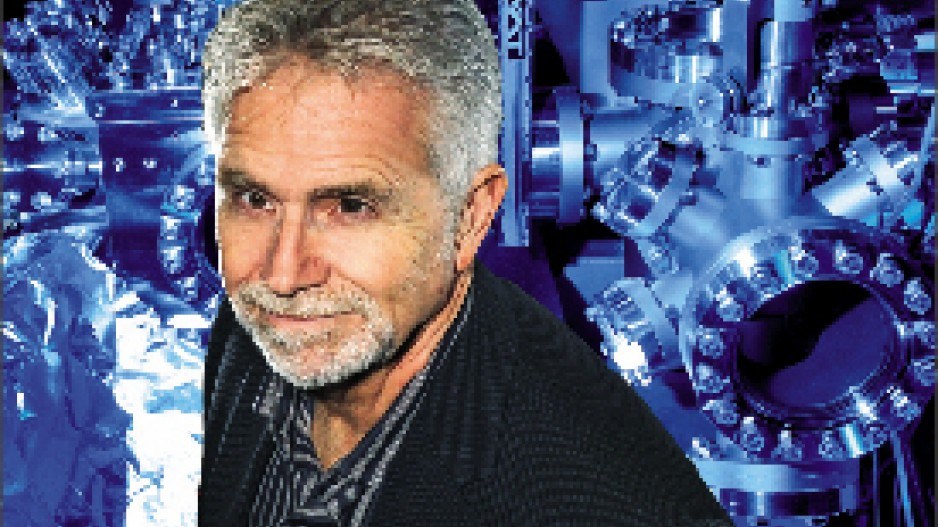Imagine if scientists could one day take CO2 – a greenhouse gas created by burning fossil fuels – and use sunlight to turn it right back into another fuel.
Scientists at the University of British Columbia’s Clean Energy Research Centre are trying to do just that.
Meanwhile, in Surrey, Nanotech Security Corp. (TSX-V:NTS) has developed optical signatures that can be used in bank notes and passports to foil counterfeiters.
What these two processes have in common is nanotechnology – the science of the minuscule.
For something that describes the infinitesimally small, nanotechnology is one very big umbrella of a word.
“It’s not really a single industry; it’s kind of a broader science,” said Alan Burgess, a metallurgical engineer and former director for Nanotech BC.
“In nanotechnology, basically, you observe, measure, manipulate and manufacture (at the nanoscale).”
The nanoscale is generally defined as the one to 100 nanometre range (nm). The smallest atom – hydrogen – is 0.25 nm in size. A human hair is 60,000 nm in diameter.
Just as loupes allowed watchmakers to create ever smaller, more precise timepieces, high-resolution electron microscopes have allowed scientists to drill down to the molecular level and “tweak” matter to add properties like strength and conductivity to certain materials.
Nanotech Security is using nanoscience for an optical effect that can be used to embed information in a variety of material to create security features that can’t be replicated by counterfeiters.
“The commercial potential is just huge,” said Nanotech Security CEO Doug Blakeway. “We’re talking a $1 billion industry in just the area we’re heading for, and that is security or authentication.”
Using a focused ion beam, Nanotech engineers can punch 20- to 200-nm holes in a variety of material – a process the company calls Nano-Optic Technology for Enhanced Security (NOtES).
An interesting thing occurs when you shine light at something perforated with holes this small: only certain wavelengths of light can get through – the rest bounce back.
Material embossed with Nanotech’s NOtES reflects a bright, shimmering image made of light. The image itself can’t be copied, so counterfeiters would be unable to replicate the effect with even the most advanced copiers or printers.
Blakeway said the technology can also be used to increase the brightness of LED lights.
Scientists have discovered that matter looks and behaves differently at the nanoscale than at the macro level and can now exploit that trait.
Carbon is a good example.
When carbon atoms are assembled in a tetrahedron shape, you get diamond, which is a poor conductor. In another form, carbon becomes graphite, which is a good conductor.
A single two-dimensional sheet of carbon atoms – graphene – can be rolled into nanotubes, which are extremely strong and conductive.
Titanium oxide nanotubes, meanwhile, are effective photocatalysts, which David Wilkinson, director of the Clean Energy Research Centre at the University of BC, believes has a range of applications in green energy, because they facilitate energy conversion.
“Nanotechnology in most things today is very important because it improves performance, whether it’s material strength, electro-chemical conversion or solar conversion,” Wilkinson said.
His team is using nanotechnology to try to convert carbon dioxide back into a fuel. Plants do it all the time, after all, using photosynthesis. The process involves using sunlight to turn carbon dioxide and water into methane and methanol. The key is a photocatalyst made of titanium oxide and copper nanostructures.
Wilkinson said no one has yet been able to convert CO2 to fuel on a scale that would make it commercially viable.
“Moving to the nanoscale gives us a better chance of doing that,” he said.
There are literally hundreds of current or potential uses for nanotechnology. Burgess said there are many potential applications in the green energy field.
“Nanotechnology and green energy have almost a symbiotic relationship,” Burgess said. “This is going to drive the green energy applications.”
Another important area is the life sciences, says Karen Cheung, an assistant professor with UBC’s biomedical microsystems and nanotechnology group.
Scientists can now engineer particles to become nano-ninjas that seek out cancer cells and deliver lethal doses of drugs.
Said Cheung, “Nanotechnology will have lots of applications in improving our health, as well as consumer products.” •




